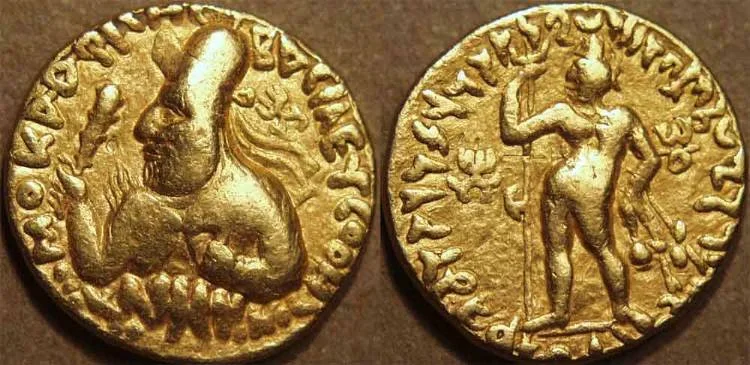
(Second part of Sanskrit inscriptions in strange places. Please read the first part as well.)
Sanskrit inscriptions older than Rudradaman (150 AD) are found on coins. A notable gold dinar coin of Vima Khadpises shows Lord Shiva with a Sanskrit inscription. It is written in Kharoshti script along with Greek script. The legend on the coin is: Maharajasa Rajadirajasa Sarvaloka Isvarasa Mahesvarasa Vima Kathphisasa Tratara. It is dated 112 AD. Vima Khadpises had issued coins with Shiva on bull (Rishaba) vahana as well.
In the mosque
Bhoja is a famous name in Sanskrit literature. There were several Bhojas and they were all great Sanskrit scholars. One such Bhoja lived during the times of Kalidasa in first century BC. But now we are looking at a Bhoja who ruled from Dhar in Madhya Pradesh. He built a temple for goddess Saraswathi. It was destroyed during Muslim invasion. The mosque had several parts of destructed temple. Fortunately one structure was left intact and that was the Sanskrit vyakarana (grammar) written as Chitra Kavi. It shows grammar in wheel shaped diagrams or pictures. This Bhoja ruled between 1010 AD and 1060 AD. He was a master of many arts and authored at least thirty books in Sanskrit ranging from astronomy to economics. One of the idols he installed is in British museum in London. But the vyakarana chakra (grammar slokas written in circular diagrams) is in the mosque itself. Now the archaeological survey has arranged for Hindus and Muslims worship on different days.
S E Asia
Most of the South East Asian Sanskrit inscriptions are written in Pallava Grantha script. We may surmise that the South Indian sculptors who travelled from the east coast must have inscribed them. It also shows South Indians were great Sanskrit scholars. South India had produced famous Sanskrit scholars like Adi Shankara,Patanjali,Nilakanta Dikshitar and they in turn wrote a lot of books until last century. In our own times Kanchi Shankaracharya’s Sanskrit composition for world peace was sung by MS Subbalakshmi in the United Nations which reverberated throughout the world.
Sanskrit can’t die as long as India and Hinduism survive. All our personal names and place names and Gods names are in Sanskrit. Even the motto of Government of India is in Sanskrit : Sathyameva Jayate-Truth alone triumphs from the Mundakopanishad. Not only the temple archanas (gods names) but also all the religious literature are in Sanskrit.
The most famous Mantra of the Hindus Gayatri (Rig Veda) has been recited by millions of Hindus for thousands of years without any break. The ancient seers (Rishis) started reciting this from 1500 BC according to Western “scholars”. But Hindus believe them s eternal sounds in the sky like radio waves. If you are at the same wavelength you can catch them like radio frequencies. So no one can call Sanskrit a dead language like Latin. Latin is used by Pope and his circle only. But Sanskrit names are used by millions of laymen. Indians can’t survive without Sanskrit. For instance if someone orders tomorrow that no Sanskrit word should be used for twenty four hours, Indians can’t function for twenty four hours. It is like ordering the entire country to stop using electricity for 24 hours. In short unlike Latin, Sanskrit has mixed with our life which no force in the world can separate for generations to come.
Anyone reading this piece, stop reading and think for a minute- think about your grandparents names, think about your friends’ names and think about your towns names and last but not the least your language. Everywhere you will find Sanskrit. This is true for all the South East Asians as well.
This divine language and its magical spell (mantra) will help India to survive for eons. When all the five big powers have gone India will survive because of it’s motto alone: Satyamebva Jayate !
